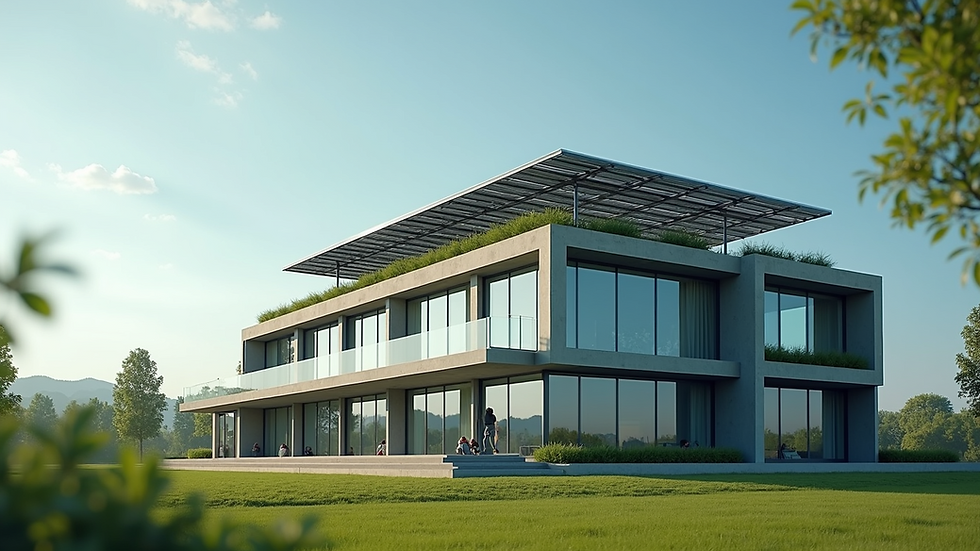Principles of Sustainable Building Design
- Felix Bauer

- Oct 13
- 4 min read
Updated: Oct 20
In the pursuit of architectural excellence, the integration of sustainability has become paramount. The principles of eco-friendly building design are not merely trends but essential frameworks that guide the creation of structures that harmonize with the environment while meeting the demands of modern urban life. This discourse explores the foundational concepts that underpin sustainable architecture, emphasizing practical applications and strategic insights that organizations can employ to achieve advanced, secure, and environmentally responsible buildings.
The Fundamentals of Eco-Friendly Building Design
Eco-friendly building design encompasses a holistic approach that prioritizes environmental stewardship, resource efficiency, and occupant well-being. It involves the careful selection of materials, energy systems, and construction methods that minimize ecological impact. Central to this approach is the reduction of carbon footprints through energy conservation and the use of renewable resources.
One critical aspect is the orientation and layout of buildings to maximize natural light and ventilation, thereby reducing reliance on artificial lighting and mechanical cooling. For instance, strategically positioning windows and shading devices can significantly lower energy consumption. Additionally, the incorporation of green roofs and walls not only enhances insulation but also contributes to urban biodiversity and air quality improvement.
Material selection plays a pivotal role. Utilizing recycled, locally sourced, and low-emission materials reduces transportation energy and indoor pollutants. Moreover, the adoption of modular construction techniques can minimize waste and accelerate project timelines, aligning with sustainable objectives.

Green roofs and solar panels exemplify energy-efficient design elements.
Integrating Technology in Eco-Friendly Building Design
The advancement of technology has revolutionized the capacity to implement eco-friendly building design effectively. Smart building systems enable real-time monitoring and optimization of energy use, water consumption, and indoor environmental quality. These systems employ sensors, automation, and data analytics to adapt building operations dynamically, ensuring efficiency without compromising occupant comfort.
For example, intelligent lighting systems adjust brightness based on occupancy and daylight availability, while HVAC systems modulate temperature and airflow to reduce energy waste. Water-saving technologies, such as greywater recycling and rainwater harvesting, further enhance sustainability by reducing potable water demand.
Moreover, Building Information Modeling (BIM) facilitates precise planning and simulation, allowing architects and engineers to evaluate environmental impacts before construction. This predictive capability supports informed decision-making, ensuring that sustainability goals are met throughout the project lifecycle.

Smart building systems optimize energy and resource management.
What are the 6 R's of Sustainable Design?
The 6 R's framework provides a comprehensive guideline for sustainable design practices, emphasizing resource efficiency and waste reduction. These principles are:
Reduce - Minimizing resource consumption and waste generation at every stage of the building process.
Reuse - Incorporating existing materials and components to extend their lifecycle and reduce demand for new resources.
Recycle - Utilizing materials that can be processed and repurposed, thereby diverting waste from landfills.
Recover - Extracting energy or materials from waste products to support other processes.
Rethink - Challenging conventional design and construction methods to innovate more sustainable solutions.
Refuse - Avoiding materials or practices that are harmful to the environment or human health.
Applying these principles requires a strategic approach, such as designing for disassembly to facilitate future reuse or selecting materials with high recycled content. This framework encourages a circular economy mindset, which is essential for long-term sustainability in the built environment.

Waste sorting and recycled materials support the 6 R's in sustainable construction.
Practical Strategies for Implementing Sustainable Building Design
To translate theoretical principles into actionable outcomes, several strategies can be employed:
Energy Efficiency: Incorporate high-performance insulation, energy-efficient windows, and LED lighting. Utilize passive solar design to harness natural energy.
Water Conservation: Install low-flow fixtures, implement rainwater harvesting systems, and design landscapes with drought-resistant plants.
Material Selection: Prioritize certified sustainable materials such as FSC-certified wood, low-VOC paints, and recycled steel.
Indoor Environmental Quality: Ensure adequate ventilation, use non-toxic materials, and maximize natural daylight to enhance occupant health.
Site Selection and Development: Choose locations that minimize environmental disruption and promote connectivity to public transportation.
Each of these strategies contributes to reducing operational costs and environmental impact, aligning with the goals of organizations seeking advanced architectural solutions.
Future Directions in Sustainable Architecture
The trajectory of sustainable architecture is increasingly influenced by emerging technologies and evolving regulatory frameworks. Innovations such as net-zero energy buildings, which produce as much energy as they consume, are becoming more feasible through advancements in renewable energy integration and energy storage.
Furthermore, the concept of resilience is gaining prominence, emphasizing the ability of buildings to adapt to climate change and other environmental stresses. This includes designing for extreme weather events, incorporating flexible spaces, and using materials that withstand degradation.
Collaboration across disciplines—combining architecture, engineering, urban planning, and environmental science—is essential to realize these future-oriented designs. Organizations must remain agile, adopting new certifications and standards that reflect the latest sustainability benchmarks.
In this context, the commitment to sustainable building design is not only an environmental imperative but also a strategic advantage, positioning firms at the forefront of innovation and market leadership.
The principles outlined herein provide a robust foundation for organizations intent on pioneering eco-friendly building design. By embracing these concepts and integrating them with cutting-edge technology and thoughtful planning, it is possible to create structures that are not only environmentally responsible but also secure, efficient, and conducive to the evolving needs of modern cities.


